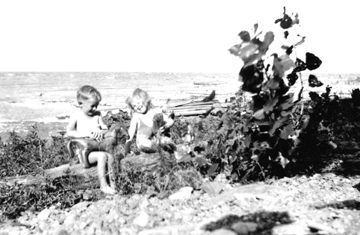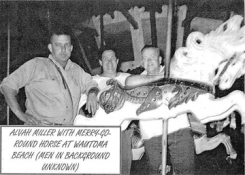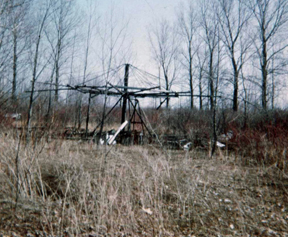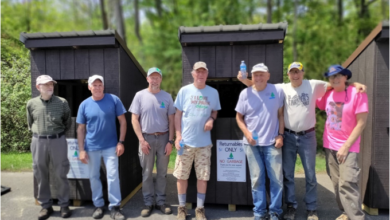Parma’s Lake Ontario beaches
by David Crumb, Hilton Historian
 The late Shirley Cox Husted and Norman Wright at Wautoma Beach. Parma Historian for many years, Shirley Husted much loved her lakeside cottage at Wautoma.In the beginning there was very little development along Parma’s Lake Ontario Shoreline, save a fisherman’s shanty, and a boat house or two. Sand dunes built up over the years where the waves broke on the beach front. Backwater marshes were just behind the sand dunes where any excess water would collect and then run back out into the lake at various outlets.
The late Shirley Cox Husted and Norman Wright at Wautoma Beach. Parma Historian for many years, Shirley Husted much loved her lakeside cottage at Wautoma.In the beginning there was very little development along Parma’s Lake Ontario Shoreline, save a fisherman’s shanty, and a boat house or two. Sand dunes built up over the years where the waves broke on the beach front. Backwater marshes were just behind the sand dunes where any excess water would collect and then run back out into the lake at various outlets.
When the Native Americans were the inhabitants of the area, they came to Parma’s beaches in the spring and in the fall. Summer was too hot with too many mosquitoes from the marshlands, and winter was too cold, dark, and forlorn. American Indians lived in a village called Canawagus near Avon, N.Y. Route 259 was their trail to the Lake, and the history books still call it the Canawagus Trail. Canawagus means “Stinking Waters,” probably because of the sulphur springs near Avon. Over the years many arrowheads and other Native American artifacts surfaced in Parma, and near the beaches, to give evidence to the Native Americans’ ancient existence in the area.
Also, it should be noted that 10,000 years ago the shore line of old Lake Iroquois (predecessor of Lake Ontario) was at Ridge Road. With time, and the melting of the glacier, the shoreline receded to where it is today. Most of Parma at that time was part of the lake bed. Bob Twentymon’s farm on Route 259 just north of Ridge Road was once part of a sandbar that extended east and west. His land is especially fertile and produces excellent vegetables. The land is quite free of rocks, however, occasionally a polished lake stone will surface.
The first white settlers shied away from being too close to the lakeshore due to the cold, and the summer mosquitoes which caused the dreaded malaria. The only recorded activity along Parma’s shoreline which extends across North Parma about 2.5 miles was Walter Vond’s boathouse at the end of Route 259. It was located on the right hand side of the road under a large willow tree by the shore. There he kept his sloop which he used to sail out onto Lake Ontario for about four miles where he would lay his nets and catch “Whitefish” which he would sell down at the Port of Charlotte for Rochester’s hotels, restaurants and taverns. Walter also assisted with the “underground railroad” activity. His father was a freed slave, and Walter did all in his power to row the fleeing slaves that came by way of Parma during the 1850s out to Canadian ships that came in the dark of night.
Up until about 1876, Hilton, then called Unionville, was a sleepy small village, a trading center for the area farmers, and later a convenient place for those farmers to spend their retirement years. In 1876, the Rome, Watertown and Oswego railroad opened up and advanced commerce along all the small lake shore communities. Hilton was bustling at this time with hotels, restaurants, boarding houses and general stores. The next 25 years saw much prosperity for Hilton, and with that prosperity, the desire for second homes along the lakeshore.
Parma beaches
Parma has eight specifically named beaches: Wautoma (once called Willow Beach); Wright’s Beach now called West Hilton Beach; Hilton Beach; Zellweger Beach; Davison’s Beach; Alder Beach; Ampor Beach; and Lighthouse Beach. Summer cottages at these named beaches were built between 1895 and 1920. From the early 1900s, until about 1965, most of the properties along the beaches were used as very plain summer homes with broad screened-in porches and unfinished second floors used for well ventilated sleeping quarters. At night one would go to sleep with the frogs croaking back in the marshes, and the waves of the lake gently lapping on the sandy shore. How could one not get a good night’s rest in such an idyllic setting?
After the 1970s, Parma’s lakeshore property became popular for year-around living. Most of the casual summer cottages that were once used from May until maybe October, were sold to people who either renovated their dwellings into four-season homes, or demolished them and built large, well insulated edifices. All through the years, residents have always had the concern of high water. There seems to be a seven year cycle. In Parma’s historical literature, an old Indian once said to an early settler: “Seven years high, seven years low.”
With the building of the St. Lawrence Seaway in the 1950s, and dams connected with that project, it seems that the lake level has remained on the high side in order to accommodate big vessels for shipping. This often threatens taxable frontage. One year an owner may have as much as 100 feet of lake frontage, and in another year, with the arrival of high water, that frontage can be reduced by as much as 50 feet, however, the taxes only seem to go up. Break walls, rocks, and other barriers to protect the lake frontage have been installed at about 80 percent of Parma’s waterfront properties, and have thus altered the natural shoreline along the lake where once there was sand, driftwood, and smooth cobblestones. Those cobblestones were used in building the area’s cobblestone homes.
For this printing in Suburban News and Hamlin Clarkson Herald, the eight beaches along Parma’s shoreline will be discussed in four parts, beginning with this review of East Wautoma Beach.
East Wautoma Beach
 Alvah Miller at the controls of the Merry-Go-Round that he ran from the ’30s, ’40s and ’50s at Wautoma Beach with tickets inset.East Wautoma Beach is located at the end of the Hamlin-Parma Townline Road. This corner, where the road ends, and the lakeshore begins, has another historical significance. It is the corner of the 1787 Phelps and Gorham Purchase where these two Massachusetts land speculators negotiated a deal with the local Seneca Indians, ostensibly enough land for a Mill Tract. All of the land from the above noted corner, all the way up to the Town of Riga and further south and then east to the Genesee River, was what they advised the Indians they needed for a Mill Seat Tract. The Indians were uncertain of what an 80 acre mill tract consisted of and signed off, and were thus swindled out of thousands of fertile acres that Phelps and Gorham later sold to the first settlers arriving in the 1790s for two dollars an acre and long credit.
Alvah Miller at the controls of the Merry-Go-Round that he ran from the ’30s, ’40s and ’50s at Wautoma Beach with tickets inset.East Wautoma Beach is located at the end of the Hamlin-Parma Townline Road. This corner, where the road ends, and the lakeshore begins, has another historical significance. It is the corner of the 1787 Phelps and Gorham Purchase where these two Massachusetts land speculators negotiated a deal with the local Seneca Indians, ostensibly enough land for a Mill Tract. All of the land from the above noted corner, all the way up to the Town of Riga and further south and then east to the Genesee River, was what they advised the Indians they needed for a Mill Seat Tract. The Indians were uncertain of what an 80 acre mill tract consisted of and signed off, and were thus swindled out of thousands of fertile acres that Phelps and Gorham later sold to the first settlers arriving in the 1790s for two dollars an acre and long credit.
 Alvah Miller with unidentified men at the popular ride.Wautoma Beach was developed out of 45 acres of the Nancy DeLavergne estate. The 1902 plat map of Parma notes that good fishing was to be found on the reef off of Willow (Wautoma) Beach. The lakeshore road running east serving the cottages is still on the town records as DeLavergne Drive. On August 19, 1920, a coal barge on its way from Sandusky, Ohio with a load of soft coal bound for Quebec got caught on the rock reef about one mile from the shore of Willow Beach. The French Canadian crew, a group of 12 men and women, were brought ashore by Lawrence McCabe and other cottagers who went out in their row boats to the rescue. The boat was later burned. Coal has been washing up on Wautoma’s shore ever since. Divers throughout the succeeding years have enjoyed underwater adventures exploring the remains of the barge. The boat had apparently sprung a leak, and with the heavy load, began to sink. The captain had hoped to make Charlotte harbor, but instead got caught on the treacherous rock reef off of Wautoma.
Alvah Miller with unidentified men at the popular ride.Wautoma Beach was developed out of 45 acres of the Nancy DeLavergne estate. The 1902 plat map of Parma notes that good fishing was to be found on the reef off of Willow (Wautoma) Beach. The lakeshore road running east serving the cottages is still on the town records as DeLavergne Drive. On August 19, 1920, a coal barge on its way from Sandusky, Ohio with a load of soft coal bound for Quebec got caught on the rock reef about one mile from the shore of Willow Beach. The French Canadian crew, a group of 12 men and women, were brought ashore by Lawrence McCabe and other cottagers who went out in their row boats to the rescue. The boat was later burned. Coal has been washing up on Wautoma’s shore ever since. Divers throughout the succeeding years have enjoyed underwater adventures exploring the remains of the barge. The boat had apparently sprung a leak, and with the heavy load, began to sink. The captain had hoped to make Charlotte harbor, but instead got caught on the treacherous rock reef off of Wautoma.
 The skeleton of the popular merry-go-round.In 1928, William Reis bought the Merry-Go-Round at Manitou Beach and moved it to Wautoma where he added a dance hall, grocery store, and shooting gallery. He had hoped to turn Wautoma into what Manitou once was and make it the new “Coney Island of the West.” The Merry-Go-Round was still in operation in the 1950s by Mrs. Reis’s second husband, Alvah Miller. Many area residents who grew up in the area will remember riding on this Merry-Go-Round and catching the brass ring to get another free ride. Rides were 10 cents each or three for a quarter. It was about the most excitement a young person under the age of 16 could find, other than the annual Hilton Firemen’s Carnival each July.
The skeleton of the popular merry-go-round.In 1928, William Reis bought the Merry-Go-Round at Manitou Beach and moved it to Wautoma where he added a dance hall, grocery store, and shooting gallery. He had hoped to turn Wautoma into what Manitou once was and make it the new “Coney Island of the West.” The Merry-Go-Round was still in operation in the 1950s by Mrs. Reis’s second husband, Alvah Miller. Many area residents who grew up in the area will remember riding on this Merry-Go-Round and catching the brass ring to get another free ride. Rides were 10 cents each or three for a quarter. It was about the most excitement a young person under the age of 16 could find, other than the annual Hilton Firemen’s Carnival each July.
Next time: Wright’s Beach, East Hilton Beach



